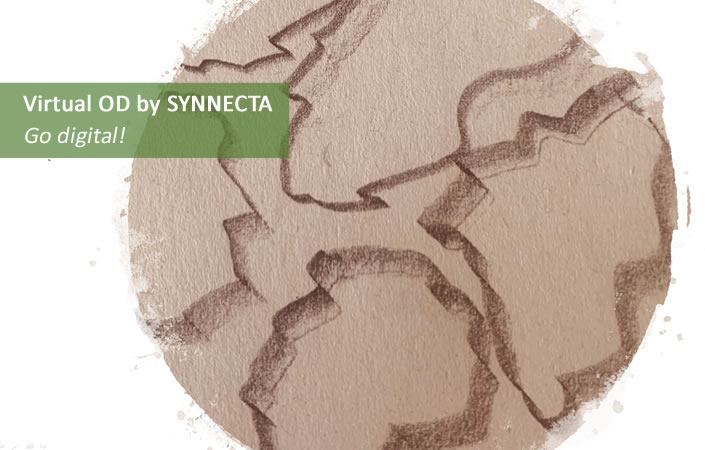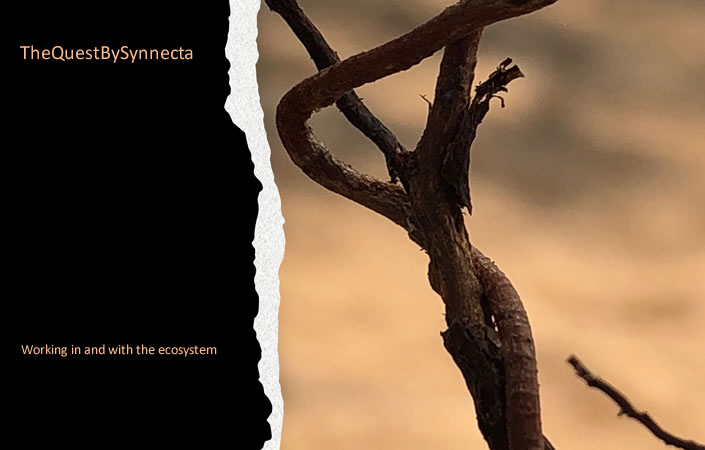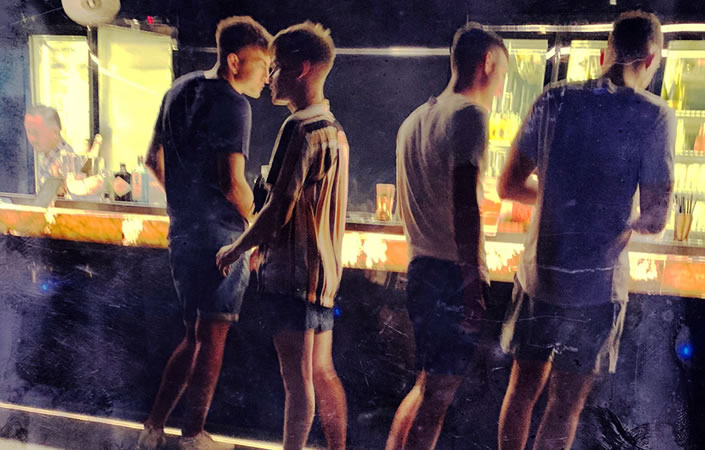18. March 2021

The digital world is a great source of new potential for organizations to foster a cultural change that is more democratic and more tuned into the future in order to address the challenges of an increasingly complex and dynamic world. In future, culture will be even more important in organizations. Culture fills gaps that cannot be bridged by structures and traditional processes alone.
Virtual organization development – Virtual OD by SYNNECTA – provides sustainable support to this aspect.
Cultural change aims to strengthen engagement, heighten performance, improve collaboration, make effective use of diversity and become more agile. It aims for the sustainable development of an organization. Only those organizations that engage in such continuous development will in the future be able to deal with change swiftly and appropriately and maintain long-term success.
Cultural change can take place from two directions
Approach 1: Central perspective – one guiding theme creates a pervasive common notion that is delivered ‘top down’ in order to integrate differences (different characteristics, metaphors, …). Further along, we see the development of islands that network self-sufficiently and influence the central pervasive message.
Approach 2: Synchronous-lateral perspectives – Useful aspects emerge automatically. Peripheral perspectives emerge laterally and enable the required multi-perspective viewpoint from the beginning. Resonance and successful action foster the emergence of new structures, which in turn resonate again and thereby reinforce each other (spiralling development) – self-sufficient organizing.
This is where Virtual OD by SYNNECTA opens up great opportunities.
Both approaches take place in conjunction in everyday Organizational Development, but are given different emphasis.
Employee community and identification with the organization serve as social glue. An organization’s strong core identity prevents it drifting apart. Communication within a continuous dialogue that provides emotional touchpoints is an essential guiding element here.
Organizational Development today: limits and challenges
Cultural transformations traditionally begin at the »centre«, meaning from an organization’s headquarters and spreading from this »epicentre« to other areas and through the entire organization in order to become »global«. The direction of change therefore goes from »central« to »local«.
In this process, thinking and acting come from the central perspective of the headquarters from the beginning. This means that the process is asymmetrical from the very start, with a decline from the centre to the periphery. Consequences can include:
- Lack of identification in the peripheral areas that are not part of the centre.
- Weaker acceptance and lacking commitment.
- Difficulties guiding the transformation on global and international levels.
- Varying depths of effect and speeds of implementation between centre and regions.
- The differences between centre and regions stay in place and may even be reinforced or increased (insider/outsider thinking).
- Important perspectives and potential from the periphery is not sufficiently included and utilized.
Successful cultural development always includes self-organized dynamics and therefore requires an approach »across the field« that departs from the notions of »top-down« and »bottom-up«, which reinforce a hierarchical mindset. The real force of renewal is therefore found in the periphery. The digital sphere provides an opportunity to strengthen or improve these aspects.

Digitalization can foster a new Organizational Development
Any organization essentially has the implicit knowledge to be sustainable for the future. However, it is often not understood how to explicitly use this knowledge. Virtual OD by SYNNECTA shifts the dynamics from central to local. At the same time, it provides an opportunity to leave to dominant notion of »top-down« and »bottom-up« behind. Organizational Development at eye level!
The three classic levers of Organizational Development are creating meaning, changing patterns and establishing commonalities. These three levers can be expanded by Virtual OD by SYNNECTA. It allows for the guiding theme to be disseminated with greater conviction (see approach 1), but even more importantly, to design self-sufficient organization more effectively (see approach 2).
The greater efficacy of virtual organizational development is mostly created by the following aspects:
- Time and space are opened, so that simultaneous activity is possible and asymmetries are eliminated.
- Synchronous and asynchronous events/communication/collaboration take place at a global level.
- Fast and high degree of networking among people in the digital space.
- The power of weak joints. Weak joints are the basis of prolific cooperation. Virtual OD by SYNNECTA uses the power of weak joints.
- More outcome thanks to focussed collaboration.
- A greater degree of self-sufficient organization, stronger interaction and involvement.
- More effective dynamics permit themes to spread virally faster.
- Creation of virtual communities (of practice).
- Greater use of creative tension through multi-perspective working in the digital sphere (using diversity).
What moves you?
- Remote work will stay with us!
- How will the dominant position of the headquarters be reduced?
- How do we achieve greater and more sustainable employee engagement?
Contact us!
18. March 2021

People in organizations expect a credible answer to this question in order to be able to establish a context for their work that delivers a sense of both purpose and meaning. Reacting to such challenges, companies position themselves with a company purpose. Until now, this purpose has almost always been developed from an inside viewpoint. However, organizations always exist in the context of an ecosystem. A meaningful purpose can only be developed in dialogue with the stakeholders of the company‘s own ecosystem. At SYNNECTA, we endeavour to give a truly multi-perspective design to these dialogue processes and thereby foster a deeper understanding of the company’s identity.
People need to work in meaningful contexts
The mindsets of societies change and shift in ways that are especially tangible to the younger generations. There is a growing desire and need for meaningful work contexts and an intention to contribute something useful for a greater whole while working. In short: living meaningfulness.
At the same time, societies are asking companies what contribution they are making to people and society. It is a question that both citizens and employees want answered.
Reacting to such challenges, companies position themselves with a company purpose. However, this purpose is still often strongly driven by a marketing outlook. The company purpose is therefore worked out within the old structures: A selected group of managers formulates a purpose that is then communicated inwards and outwards with considerable effort.
A range of perspectives – those that have developed out of the highly diverse employee population, from the clients, sectors of society and the markets – are hardly represented. So far, there has been a lack of real and open dialogue between the interest groups. A shared understanding to provide a basis for a company purpose cannot be developed this way.
Understanding our own identity in the context of the ecosystem: »What are we for?«
Organizations evolve and exist in the context of various stakeholders: markets, clients, competition, partners, society, employees, etc. All of these systems are in continuous exchange and yield an influence on each other. Together, they make up an ecosystem. Since organizations are always part of an ecosystem, they can only arrive at an understanding of their own role within the context of that ecosystem. The identity of an organization is defined through a constant exchange with the ecosystem.
Developing an organization’s identity that can provide meaning and a sense of community must therefore focus on asking:
- What are we for? What is our contribution to our ecosystem?
Any answer to this question that is found only from within the organization will establish a limited and frequently distorted perspective. It is based on hypotheses about the self and the world that were developed along many paths, but never in exchange with that very world, the stakeholders in the own ecosystem.
A true understanding of the own identity requires direct dialogue with the various stakeholders that make up the own ecosystem. It needs to come from a perspective that goes from the outside in:
- What do you need?
- What can we do for you?
- What can we do together?
- How should we be from your point of view, what makes us attractive partners to you?
Dialogue and joint examination of the own ecosystem
We create shared dialogue spaces with the stakeholders of the ecosystem and therefore make it possible to create a joint, multi-perspective debate to achieve a common and shared guiding theme. All relevant viewpoints will find a place where they can learn from and with each other: about themselves, about joint interests, about shared potential. This process then underlies a grasp of the own identity and the own purpose. This guided dialogue allows synergies to emerge. The multi-perspective process expands everyone’s thinking. The processes of creation and implementation come together and establish a high degree of commitment for the joint cause.
Our Approach:
- The organization chooses an overall guiding theme for the dialogue in the ecosystem.
- A suitably wide spectrum of various stakeholders is invited to join in and explore this guiding theme together.
- Shared, relevant questions that pertain to the guiding theme are developed together with the stakeholders.
- Further guiding questions will support the moderation of a substantial and demanding dialogue that is fundamentally set out to take in many perspectives.
- Promising impulses from the dialogue can be adopted and can kick off future initiatives and joint projects.
- The stakeholders can develop further individual conclusions and measures from the shared insights.
The choice of stakeholders is essential to the success of the process. A successful dialogue fosters new insights and therefore needs to start from a sufficient degree of difference. It requires constructive juxtaposition. Here lay the great challenges and the opportunities of multi-perspective dialogue processes: allow differences, let them have an effect and develop deeper, shared insights together with them.
29. January 2021

It is a well-known challenge: how can an organization gain and maintain a recognizable identity that gives direction to the conduct of its entire team? The history of large companies is usually shaped by mergers. Surprisingly, we often find deep-rooted and dominant origins identities there. These may reveal themselves even decades after a merger in people’s attitudes, in their decision-taking, and in the stories that are told. A deep-rooted sense of belonging and emotional ties to the identity of the existing, evolved community, on the other hand, are lacking. Such dynamics are not limited to companies that are shaped by mergers. It is apparent that companies are more and more fragmented. The periphery has gained importance. Different markets that demand different strategies support different self-attributions. The range of working methods is also expanding at speed: agile approaches demand various degrees of self-organization, and these bring with them a range of structures and means of performance as well as different expectations of that performance. There are cracks running through the sense of community that encompasses a company.
A decade ago, the answers that were found for these cracks included finding common values and formulating as well as intensively communicating a brand for the company. To this day, accordingly, such influence is administered via the internal modes of communication in waves: themes include values, leadership behaviour, compliance, as well as individual claims that are meant to describe an overarching identity. Sanctions and their mechanisms evolved at the same time, as is usual within the bureaucratic structures that we cannot escape.
Rhetorical purpose and a more vocal public have fostered the addition of claims that define the company as »good«: helpful and useful for society. At first, there was an easy acceptance that such an identity and its guiding role for personnel conduct would come from within the hierarchical structures. Nowadays, employees and other relevant stakeholders lay claim to their own contribution: they step beyond the boundaries of the company.
Looking at societies and how political communities form, we see that they have each had to confront that very same problem. The educational canon and the teaching of a common language have been central to these processes. While companies have comparable structures in their education and training departments, they only make limited use of the great potential that lies within them. A joint administrative infrastructure is often felt to be a mode of centralization, centring on the »corporate« structure. However, that and the education of elites are further measures that are used to design a common identity. The great festivals in companies go by such names as leadership meetings and company days. Whether they take place in person or in the virtual world: they serve more than anything the celebration of an emotionally designed identity that is created and experienced there. They are celebrations of a community – of »us«. Once this sense of identity has been fostered, however, it is often difficult to translate it into concrete modes of conduct and performance. That is the burden of bureaucratic work.
The peripheries are gaining increasing influence in shaping the steady development of identifiactions. Among other factors, that is due to the greater mobility of those who work on the peripheries of a company: their mode of life relates to reaching rather than keeping.
In short, we are witnessing a constant dynamic in the achievement and strengthening of company identities, using the same means as those by which national identities are formed. Accordingly, there is even now a desire for charismatic leadership, CEOs who visibly represent something and who are able to communicate that something emotionally. Even though our individual projections may differ, we are all looking in the same direction: towards the CEO. That creates our sense of community.
At the same time, however, the classic top-down approaches no longer suffice. Contribution is gaining weight and going beyond a mere »form of communication«. Dialogue is the only key to shaping the kinds of identity that are currently in demand, effective, and able to guide performance. Once again, the process is more important than a »printable« result. Important stakeholders include the entire workforce as well as the shareholders, the management, relevant representatives of the market and nowadays also of societies. It is an extremely challenging enterprise to put such a process of dialogue into action within a large global company. With »theQuestbySynnecta«, #Synnecta has developed models that can shape even expansive and diverse dialogues effectively. They even have a welcome and pleasing side effect: the inside-outside mode of thinking and decision-taking that still has a wide foothold is turned around (or turns itself around), guiding the companies into a new form of outside-inside thinking that is a critical marker of success in these new times of networking.
Rüdiger Müngersdorff
29. January 2021

How we see the world, and what we know about it, is shaped by what has gone before: it is conditional. The notion that our perception and understanding creates an image of the world has long been doubted. At least since the time of Kant, we have known that perception is shaped by a priori concepts, which include how we assess space and time within our perception as well as, for example, the role of causality in understanding. We shape our perception of reality, we do not make an image of it. Hermeneutics, the philosophy of language, has differentiated further the notion that we shape our perception and understanding. Psychology has revisited the epistemological analysis in addressing the meaning of our individual cognitive and emotional development for the way we perceive and understand an internal as well as an external reality, centring on the idea of repetition. This relates further to the works of cultural anthropologists and sociologists who first identified class-specific patterns in perception, understanding and action (the concept of mentality), in order to subsequently expand this to take in the construction of national patterns of perception and thinking. In our times, radical constructivism has addressed the conditions that shape our access to reality. It significantly influenced what we now define as »systemic«: one of the modern foundations of organizational development.
The introduction of the systemic approach has made it clear, among other things, that the structure of a chain of cause and effect can only provide a limited understanding of individual and collective perceptions, ways of thinking, emotional states and accordingly means of decision-taking and performance. Cause and effect works perfectly on all things that are consciously created and manufactured by humans, but is less powerful when it comes to actions set by individuals and collectives. These require an additional understanding of conditionality. That concept is not as clear-cut as the principle of cause and effect. There is not a single condition that lets us understand a particular mode of conduct. Once again, however, it is a concept that is not new: we find it in Buddhist thought, which may explain why an iterative way of working is so much more easily realized in the Asian context.
Mindset describes what used to be called culture in organizational development. Both terms have the advantage that they are highly unspecific and therefore applicable to a range of approaches. While there is always a marketing aspect to be borne in mind in the evolution of concepts in organizational development, we can nevertheless learn from recent analyses of culture and mindset. We construct our reality both individually and collectively from the viewpoint of our individual and collective habits, of where we have evolved from. In the concepts of radical constructivism that also includes functional adaptation. Our decisions and actions are therefore based individually as well as collectively on a priori concepts: they are shaped by what has come before our current reality.
The more recent work on mindset has the advantage that it concentrates more fully on methods that allow us to focus with greater awareness on some of these a priori concepts that shape us. It is a useful method to achieve reasonably fast results for our own conduct. In doing so, we tend to overemphasize our individual mindset in line with the modern credo that »I am the master of my perception, insight and action«. While it is useful to uphold this notion in order to sustain a subject that is autonomous in action, it also leads us to overlook the collective conditions that shape our perceptions, insights, emotions and eventually our decisions and actions. We need a clear awareness of the collective mindset and, going on from there, methodically expand on its significance. Otherwise, mindset work will remain a limited tool in organizational development.
With #Myndleap, #sisko #oudheusden #muengersdorff are zooming in on methodical work with collective mentalities – mindsets – that enables change. It is the only path to achieving sustainable profit for organizations.
The guiding principle was formulated by Ernst von Glasersfeld in 1987, based on the thesis that we establish the very world we perceive involuntarily because we do not pay attention to – and therefore obviously do not know – how we do so. It is a deeply unnecessary lack of awareness. Radical constructivism, similarly to the critique offered by Kant, states that we are largely able to tap into the ways by which we construct the world we experience. The resulting awareness in our operative actions (…) can help us change and maybe improve. (Ernst von Glasersfeld: Wissen, Sprache und Wirklichkeit, Braunschweig 1987).
The »maybe« that Glasersfeld inserted into his hopeful sentence makes it clear how much all that talk about a growth mindset simplifies matters. Where do we find hope? By individually and collectively becoming aware of the a priori concepts that mostly shape our perception, sensation, decision-taking and conduct subconsciously, we gain the freedom to do things differently.
Rüdiger Müngersdorff
Photo: Danny Lines by unsplash.com
5. November 2020

No empathy without scenic competence. We do not feel into another being nor is our feeling a kind of sense aimed to perceive the emotional situation of another being. Empathy is a skill; we learn it in our life. We understand another’s (persons or groups) feelings (emotion, perception, needs, thoughts, motives …) by our learned ability to reproduce a scene in which the others are situated and acting. Empathy is a creative skill. With it we re-enact the scene of others and by doing so we can reproduce the inner experiences of another being. So, it is not without reason that one of the sources of the empathy concept is a way of understanding art. It was transferred into a psychological concept by Theodor Lipps.
To understand how to learn the empathetic skillset we have to differentiate between the scenic empathy, recognizing in what emotional loaded scene another is perceiving and acting on one hand and on the other the intrapsychic empathy, to react with our own feeling to our cognitive scenic understanding.
For a better scenic understanding and with that scenic empathy it is immensely helpful to look into the sociometric, psychodramatic concept of a role swap by J.L. Moreno and the theory of the humanistic psychodrama. In a proverb of native Americans, it is described as:
»Do not judge about someone if you have not a moon long walked in his/her moccasins.«
Scenic understanding is learnable, learnable even in a training. With the important second part of empathy, the intrapsychic empathy its different. Still, it is learnable, but not in a classical leadership training put into a 45 min timeframe. You may in a cognitive way understand the scene of others, but to have an empathetic moment you need your own inner reference, similar own experience. For that you need to have a full, in experiences rich life. A good leadership session may give you some new and touching experiences, but it can not be the substitute for a fully lived life – one of the reason why we look different into a curriculum vitae, asking for an experience full and very vivid lived live.
Rüdiger Müngersdorff






